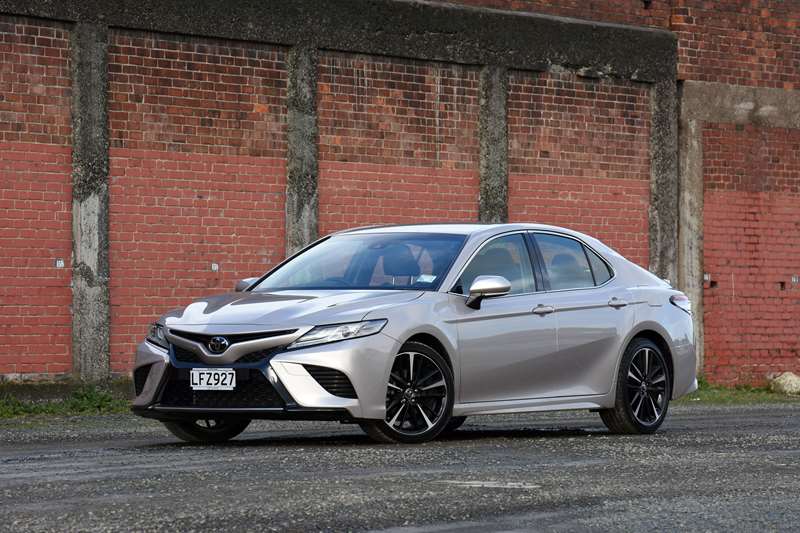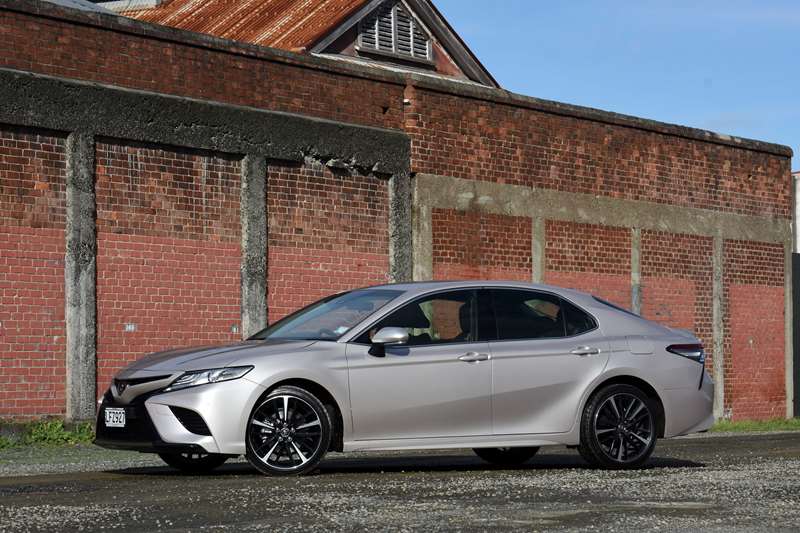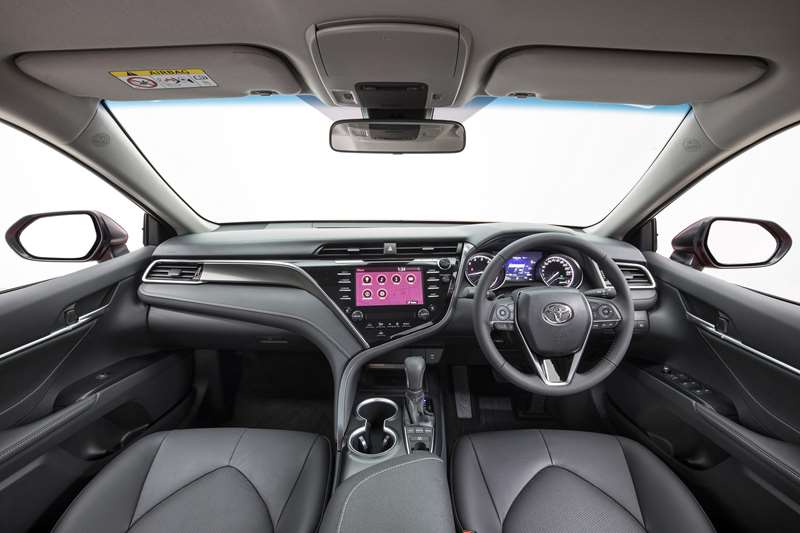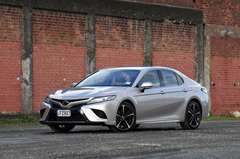| Price: | 47990 |
|---|---|
| Engine: | 3456cc quad cam six-cylinder, maximum power 224kW@6600rpm, maximum torque 362Nm@4700rpm |
| Transmission: | Eight-speed automatic, front wheel drive |
| Brakes and stability systems: | Front and rear disc brakes, ABS, BA, EBD, TRC, HAC, VSC |
| Safety: | Ancap five-star |
| Wheels and tyres: | Alloy wheels, 235/40 R19 tyres |
| Fuel and economy: | 8.9 litres per 100km, fuel tank capacity 60 litres |
| Emissions: | 202 grams of CO2 per kilometre |
| Dimensions: | Length 4905, width 1840, height 1445 |

What We Like
- Great design and dynamic panache
- smooth and willing V6 engine

What We Don't
- Relatively thirsty by modern standards (though the more economical four-cylinder and hybrid Camrys are available too)
Verdict
Mission accomplished, with the staid Camry old consigned to memory, at least as a new car
Rating:
Overview
Banishing boring has become something of a mantra for Toyota of late, and it’s an approach
that is every bit as evident with the latest Camry as with other recent additions to the company’s
range, such as the new Corolla.
While displayed most obviously in a recent move to more adventurous styling, this approach
is also reflected by the addition of more sporty models within the company’s range.
Enter the V6 version of the seventh-generation Camry, which was launched earlier this year.
Yes, there have been V6 Camrys before, but not for years: the previous version bowed out with
four-cylinder petrol and petrol-electric hybrid versions as part of the mix. Both carry over to
the new Camry range, and will surely be the strongest sellers.
Priced at $47,990, in a range that opens with the $35,990 four-cylinder Camry GL, the V6
features a 224kW/362Nm quad cam motor. It also differs from other members of the range in
having an eight-speed automatic gearbox rather than a six-speed or (as used by the hybrid) a
continuously variable transmission.
A little larger than its predecessor and, with a wider track, longer wheelbase and lower
roofline, its proportions are more dynamic. This is capitalised on by sleek styling, anchored up
front by a Lexus-style spindle grille.
Inside, the Camry remains an intensely practical saloon. Its boot has a generous 524-litre
capacity, rear leg and shoulder room is excellent, and back seat occupants have their own air
vents and chargeable USB sockets.
The front of the cabin is spacious and ergonomically spot-on, while the angular asymmetry
of the dash is illustrative of interior design flair not before seen on a Camry. On the V6 test car,
carbon-fibre and chrome highlighting give a further lift, along with extensive soft-touch
surfacing and stitched leather trim.
As the flagship, the V6 has strong standard specifications, including keyless entry and start,
a wireless charge pad towards the base of the centre console, a head-up display, dual zone
climate control, auto-dipping headlights, satellite navigation, autonomous emergency braking,
lane departure alert with steering assist, trailer sway warning and all-speed radar cruise
control.
The centre colour touchscreen is, for the most part, a user-friendly interface, although some
elements of the satellite navigation are not as instinctive as they could be.
Overall, the cabin ambience of the test car was closer to what one might expect from an
equivalent-sized Lexus model than a mainstream Toyota. The same was true of its mechanical
smoothness.
In most situations, the engine and gearbox were understated in their power delivery. This is
likely to be due to the transmission’s shift calibration and, in particular, its reluctance to kick
down quickly, even with sport mode engaged. Additionally, with torque not reached until
4700rpm and peak power until 6600rpm, comparatively little of the engine’s potential is
unleashed at light or even moderate throttle openings.
Such mechanical restraint is a probably a good thing for those who value smooth cruising and
reasonable fuel economy, but drivers seeking something more need to get actively involved,
flicking into sport mode, selecting gears via the vehicle’s paddle-shift controls and working the
accelerator hard. The test car displayed ample pep when this approach was taken, while
remaining smooth.
The new Camry’s more rigid chassis, lower centre of gravity and adoption of a double-
wishbone rear suspension set-up mean it is a far sharper machine than the model it replaces.
And, within the new family, the V6 is probably the best-handling of the lot.
CAMRY HYBRID
Presumably in the interests of containing cost, the new Camry’s hybrid system sticks with the
previous model’s nickel-metal hydride batteries rather than switching to the a more efficient
lithium-ion system. Even so, there is significant change with the electric element of the hybrid
drive operating in conjunction with a new 2.5 litre petrol engine.
The set-up offers the dual benefits of increased power and improved economy, with that last
gain benchmarked at 19% over the previous Camry hybrid on the standard economy cycle.
Aside from a CVT-accentuated tendency of the motor to sound thrashy when worked hard, the
new system was impressive on test. Decent and — under lighter throttle loads — very smooth
performance was accompanied by an excellent 5.2l/100km economy return during several days
of fairly typical driving in and around Dunedin.
Thanks to those changes in chassis and suspension that also benefit the V6 Camry, the
handling of the hybrid is also markedly improved when compared to the old model, and
refinement is far better overall, too.
- Copy and photos by David Thomson










